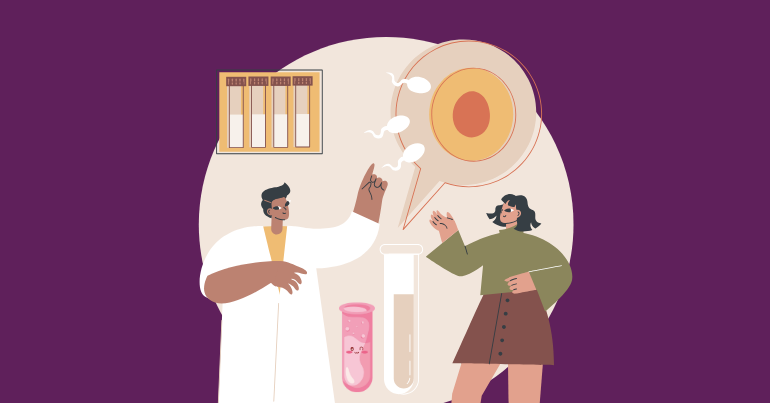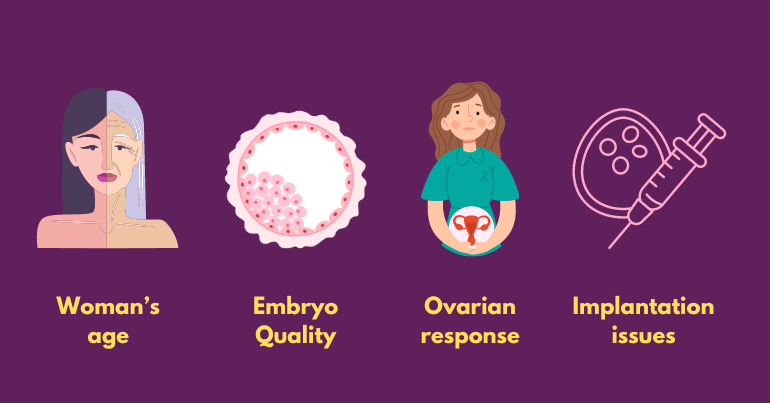Are you having difficulty conceiving a baby? No worries. The development of medical technology has aided in the birth of new families for couples all over the world. Millions of people worldwide have conceived healthy babies thanks to artificially assisted reproductive treatments (ART), also known as test tube baby treatment.
NimaayaIVF Women’s Hospital is the best test tube baby center in Surat, and this blog will discuss the test tube baby process, its cost, risk, and many more things in detail!
What is Test Tube Baby?

A test-tube baby is a child born from successful human reproduction that uses medical intervention to manipulate both the egg and sperm cells. The term was originally used to refer to babies born from artificial insemination but has since expanded to include children born through in vitro fertilization, which involves fertilizing an egg outside of a woman’s body. The term has been accompanied by discussion and controversy regarding the ethics of reproduction technologies such as artificial insemination and in vitro fertilization.
The first IVF was performed by William Pancoast in 1884, but the media didn’t recognize its significance. As reproduction technology advanced, the media began to pay attention to test-tube babies. In 1978, British researchers revised the definition, creating Louise Brown, the first child born from a zygote fertilized outside of a human body. This led to the development of fertility clinics and successful test-tube baby births.
A condition that needs a Test Tube Baby
Test Tube Baby is a solution for all couples experiencing infertility problems, whether for known or unknown causes. Below is the list of conditions that might require an IVF procedure to experience parenthood.
▹ Tubectomy
Conceiving through a test tube is an option if the fallopian tubes are ligated, which can lead to pregnancy failure.
Also Read: Tubectomy: Understanding the Procedure and Its Benefits
▹ Ovulation Issues
One of the most frequent causes of unintended pregnancies is ovulation issues. On the other hand, you can overcome infertility and retrieve healthy eggs by having a test tube baby. Irrespective of the ovulation issues, whether it is a lack of egg production or the absence of high-quality eggs, IVF or a test tube baby can help you subside the problem.
▹ Improper Sperm Count
A decreased sperm count in male partners is yet another factor contributing to infertility or unsuccessful natural conception. You can depend on Test Tube Baby to address infertility in cases of poor sperm quality and reduced sperm count.
▹ Genetic Concerns
Experts at Test Tube Babies advise doing the procedure when there is a chance that genetic disorders will be passed from parents to their offspring.
▹ Unknown Infertility Issues
When doctors diagnose both male and female partners and still cannot find the reason, they recommend Test Tube Baby as a solution.
▹ Blockage in the Fallopian Tube
A blocked fallopian tube is one of the prime hindrances to fertilization. Because the fallopian tubes are the only pathway for sperm to reach eggs, any damage or scarring results in infertility. However, with Test Tube Baby, the pregnancy is feasible despite the existing blockage in the fallopian tubes.
▹ Endometriosis
A test tube baby procedure is an effective treatment for endometriosis, an infertility condition that affects the uterus, fallopian tubes, and ovaries in women. This is made possible by medical advancements.
All of the above-mentioned infertility problems as well as many other infertility problems can be resolved with a test-tube baby. Nonetheless, infertile couples ought to think about consulting an IVF specialist.
Deciding Factors of the Test Tube Baby Process

▹ Woman’s age
Success rate increases when the age of a woman is below 30 – 35 years
▹ Embryo Quality
Weak embryos unsuited for this procedure are those with chromosomal and genetic abnormalities.
▹ Ovarian response
In case the ovaries do not respond firmly to the medications and are not able to create multiple eggs.
▹ Implantation issues
Because of implantation issues, half of the cases have gone wrong. This can occur when the embryo discontinues growing naturally.
Also Read: Understanding the IVF Process: Step-by-Step Guide to Assisted Reproductive
How Test Tube Baby is Born
▹ Hormone Therapy and Egg Production
To create a test tube baby, the first step is to stimulate the female’s body to produce eggs. Mostly, two injectable hormones that are prescribed by doctors are used for this purpose: gonadotropins and GnRHa. The female receives these injectable hormones in a titrated dose, which causes the follicles already existing in her ovaries to develop and mature. The final stage of egg maturation is completed by hCG injection. Egg collection is done 36 hours after receiving the injection hCG.
▹ Egg Retrieval
The next step after hormone therapy is to remove the eggs from the body through a small surgical incision. To minimize any potential discomfort, the procedure is done under general or local anesthesia. A vaginal ultrasonography probe with an attached needle is used to retrieve the eggs. The needle is inserted in each ovary, and fluid from all formed follicles is aspirated. The fluid is seen under the microscope to identify the eggs, which are then kept in a petri dish in a specialized medium in the incubator.
▹ Sperm collection
On the day the eggs are retrieved from the female’s body, the male also has to submit a fresh sample of semen. This is needed because the next, and most important, stage in the creation of an IVF requires the collection of both sperm and eggs.
▹ Petri Dish
One of the most important steps in the entire test tube baby process is combining the collected sperm and eggs in a petri dish. After combining the sperm and eggs, the petri dish is kept in an incubator. The specialist examines the mixture to look for any evidence of fertilization the next day and also keeps track of the development of the embryo in the following days. This is necessary to make sure the embryo is growing well and to ascertain that the embryo is ready for transfer to the uterus.
▹ Final Transfer to Uterus
The final step in producing a test tube baby is inserting the prepared embryos into the uterus. One to three separate embryos are transferred to the woman’s uterus using a very thin catheter. Hormonal support is given after the embryo transfer to support a possible pregnancy.
But to find out if you’re pregnant, your blood beta-HCG levels are measured 14 days after the embryo transfer procedure. For a single embryo transfer cycle during a test tube pregnancy, the success rate is up to 50 %, and for three embryo transfer cycles, the success rate is a cumulative 85–90%.
Test Tube Baby Price
The test tube baby cost in India is not fixed and varies greatly depending on
- Cause of infertility
- Age of the couple
- Medical history
- Diagnosis and Medication requirements
- Number of cycles required for successful results
- Location of treatment
- Experience of doctors, and more
On average, the cost of a single IVF cycle in India can range from INR 1,00,000 to INR 2,50,000. This cost typically includes consultations, medications, monitoring, and the actual procedure itself.
Apart from the inclusions about the Test Tube Procedure in India, here is a sneak peek into the side effects of the process.
Are There Any Side-Effects of Undergoing Test Tube Procedure?
The dilemma of deciding whether or not to opt for Assisted Reproductive Technology is real. For those already enjoying parenthood because of a Test Tube Baby Procedure, it’s a boon, while for others who do not take the first step to consult, it’s confusing. In addition, apprehensions regarding the Test-tube procedure sometimes delay a couple’s decision. This brings us to the question: are there any negative effects?
Side-Effects of an IVF Procedure
- It may result in multiple pregnancies.
- There might be a slight risk of vaginal infection during the embryo transfer process in the uterus.
- There is a chance of miscarriage in certain cases where the mother is older than 35.
- Mothers may occasionally experience vaginal swelling.
- The baby may weigh less when it is born.
While it would be incorrect to suggest that having an IVF Treatment is completely risk-free, there are some mild and controllable side effects. There is no side-effect of the process that might risk a mother’s life.
Is the Test Tube Baby Procedure Painful?
The test tube baby process has a different effect on each patient, and what may be painful to some may not be for others. Although it is normal to be uncomfortable during some parts of the process, such as injections or egg retrieval, there is no/ minimal pain during the procedure and the presence of severe pain may indicate complications and should be discussed with the treating doctor on an urgent basis
Conclusion
Nowadays, you can easily have a safe and healthy newborn thanks to advanced processes. Artificially-assisted Reproductive Treatments (ARTs), like test tube baby treatment, can help you have a baby on an affordable budget.
You can have effective and reliable infertility treatments at Nimaaya, the best test tube baby center in Surat. You can choose to have an IVF procedure and work with us to conceive a healthy child. Under the guidance of experienced and talented doctors, you can have a safe and effective procedure, ensuring a safe baby. With the latest technology and experience of the IVF expert, you can have a precise diagnosis and effective treatments. We also provide post-treatment care to keep you and your baby healthy. So, embrace parenthood and fulfill your dream of having a baby only with the Nimaaya test tube baby center. Book your appointment now and begin a new journey toward parenthood.


Comments 1
A test-tube baby refers to a child conceived through medical procedures that manipulate egg and sperm cells, initially coined for babies born from artificial insemination and later expanded to include those born through in vitro fertilization (IVF). Controversy surrounds the ethics of such reproductive technologies. While William Pancoast performed the first IVF in 1884, it wasn’t recognized until British researchers achieved the birth of Louise Brown in 1978, marking a significant milestone in reproductive medicine. This event spurred the establishment of fertility clinics and widespread success in test-tube baby births.